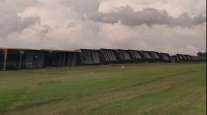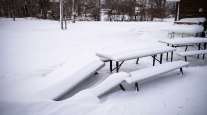Spring Snowstorm Buries Midwest, Tornadoes Possible in South

Strong winds and more snow hit the Midwest on April 12 after a spring storm buried several states in snow and created dangerous travel conditions, while forecasters warned of potential weekend tornadoes in the South.
The storm hovering over parts of Minnesota, South Dakota and North Dakota was the second “bomb cyclone” storm system to hit the region in a month. The storm moved in April 11, closing highways and knocking out power to tens of thousands of people.
It also left behind 25 inches of snow in northeast South Dakota, where Gov. Kristi Noem closed government offices in most of the state for a third straight day April 12. Parts of Nebraska were buried in more than a foot of snow and even deeper drifts, thanks to winds gusting to more than 60 mph.

A row of power line poles are snapped from ice and wind April 11, near Browndale, Minn. (Andrew Link/alink@postbulletin)
Several snow-packed highways remained closed April 12 in Nebraska, and forecasters warned that unseasonably low temperatures would remain through the weekend. Minnesota Gov. Tim Walz declared a state of emergency in much of his state, where the Minnesota State Patrol has responded to more than 500 crashes since April 10.
“It’s a mess out here. And that is an understatement,” State Patrol Lt. Gordon Shank said late April 11.
In parts of the South, the National Weather Service warned church pastors to have someone monitor the weather during April 14 services amid heightened risk for damaging tornadoes.
Gusty wind, hail and potentially tornadoes were forecast April 13 in parts of Louisiana, Mississippi and western Alabama, according to weather service forecaster Adam Baker. Similar weather was forecast in southern Arkansas and eastern Texas. Local flooding also was possible.

Waves pound the shoreline at Tettegouche State Park April 11 in Silver Bay, Minn. with wind gusts up to 50 miles per hour. (Brian Peterson/Star Tribune)
Thunderstorms were expected to move into much of Georgia and the rest of Alabama on April 14, with the possibility of isolated and less severe tornadoes, as well as large hail and damaging winds.
“Even a weak tornado that hits the right location can still be pretty devastating,” Baker said.
The weather service office in Birmingham advised pastors to figure out the safest location for their congregations in case of severe weather, noting that large open rooms such as sanctuaries and auditoriums weren’t safe.
A series of tornadoes on Palm Sunday in 1994 killed 40 people in Georgia and Alabama, and injured hundreds more. Half the deaths occurred when a tornado struck a rural Alabama church during services, causing the roof to collapse, according to a report about the damage by U.S. weather officials.




